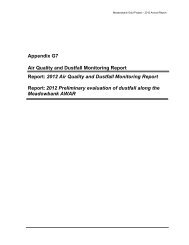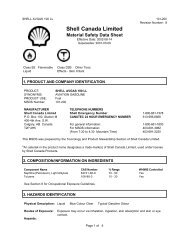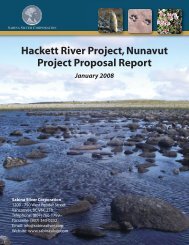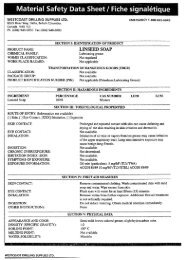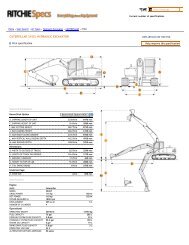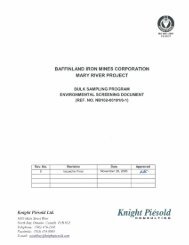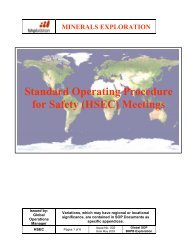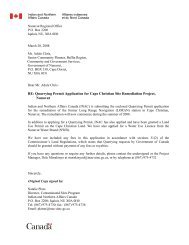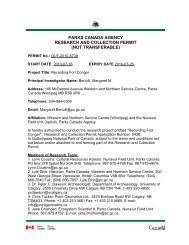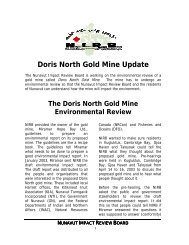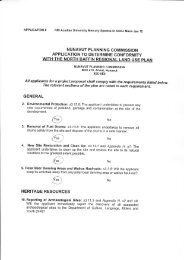REGULAR UNLEADED GASOLINE
REGULAR UNLEADED GASOLINE
REGULAR UNLEADED GASOLINE
You also want an ePaper? Increase the reach of your titles
YUMPU automatically turns print PDFs into web optimized ePapers that Google loves.
<strong>REGULAR</strong> <strong>UNLEADED</strong> <strong>GASOLINE</strong> 211-001<br />
Revision Number: 4<br />
Shell Canada Limited<br />
Material Safety Data Sheet<br />
Effective Date: 2002-08-14<br />
Supersedes: 2001-01-08<br />
Class B2 Flammable<br />
Liquid<br />
Class D2A Other Toxic<br />
Effects - Carcinogen<br />
1. PRODUCT AND COMPANY IDENTIFICATION<br />
PRODUCT: <strong>REGULAR</strong> <strong>UNLEADED</strong> <strong>GASOLINE</strong><br />
SYNONYMS: Automotive Fuel<br />
Petrol<br />
PRODUCT USE: Fuel<br />
MSDS Number: 211-001<br />
MANUFACTURER TELEPHONE NUMBERS<br />
Shell Canada Limited Shell Emergency Number 1-800-661-7378<br />
P.O. Box 100, Station M CANUTEC 24 HOUR EMERGENCY NUMBER 613-996-6666<br />
400-4th Ave. S.W.<br />
Calgary, AB Canada For general information: 1-800-661-1600<br />
T2P 2H5 For MSDS information:<br />
(From 7:30 to 4:30 Mountain Time)<br />
403-691-3982<br />
403-691-2220<br />
This MSDS was prepared by the Toxicology and Product Stewardship Section of Shell Canada Limited.<br />
*An asterisk in the product name designates a trade-mark(s) of Shell Canada Limited, used under license<br />
by Shell Canada Products.<br />
2. COMPOSITION/INFORMATION ON INGREDIENTS<br />
Component Name CAS Number % Range WHMIS Controlled<br />
Gasoline, Natural 8006-61-9 80 - 100 Yes<br />
Benzene 71-43-2
<strong>REGULAR</strong> <strong>UNLEADED</strong> <strong>GASOLINE</strong> 211-001<br />
Revision Number: 4<br />
Hazards:<br />
Handling:<br />
Flammable Liquid.<br />
May cause cancer.<br />
Vapours are moderately irritating to the eyes.<br />
Ingestion may result in vomiting. Avoid aspiration of vomitus into lungs as small<br />
quantities may result in aspiration pneumonitis.<br />
May be absorbed by skin contact. Prolonged immersion in liquid may lead to<br />
chemical burns.<br />
Vapours are moderately irritating to the respiratory passages. The liquid when<br />
accidently aspirated into the lungs can cause a severe inflammation of the lung.<br />
Excessive exposure to benzene may cause leukemia in man.<br />
Eliminate all ignition sources.<br />
Wear suitable gloves and eye protection.<br />
Bond and ground transfer containers and equipment to avoid static accumulation.<br />
Avoid prolonged exposure to vapours.<br />
Empty containers are hazardous, may contain flammable / explosive dusts, liquid<br />
residue or vapours. Keep away from sparks and open flames.<br />
For further information on health effects, see Section 11.<br />
4. FIRST AID<br />
Eyes:<br />
Skin:<br />
Ingestion:<br />
Inhalation:<br />
Notes to Physician:<br />
Flush eyes with water for at least 15 minutes while holding eyelids open. If irritation<br />
occurs and persists, obtain medical attention.<br />
Wash contaminated skin with mild soap and water for 15 minutes. If irritation<br />
occurs and persists, obtain medical attention.<br />
DO NOT INDUCE VOMITING! OBTAIN MEDICAL ATTENTION IMMEDIATELY.<br />
Guard against aspiration into lungs by having the individual turn on to their left side.<br />
If vomiting occurs spontaneously keep head below hips to prevent aspiration of<br />
liquid into the lungs.<br />
Remove victim from further exposure and restore breathing, if required. Obtain<br />
medical attention.<br />
The main hazard following accidental ingestion is aspiration of the liquid into the<br />
lungs producing chemical pneumonitis. If more than 2.0 mL/kg has been ingested,<br />
vomiting should be induced with supervision. If symptoms such as loss of gag<br />
reflex, convulsions or unconsciousness occur before vomiting, gastric lavage with a<br />
cuffed endotracheal tube should be considered.<br />
5. FIRE FIGHTING MEASURES<br />
Extinguishing Media:<br />
Dry Chemical<br />
Carbon Dioxide<br />
Foam<br />
Water Fog<br />
Page 2 of 6
<strong>REGULAR</strong> <strong>UNLEADED</strong> <strong>GASOLINE</strong> 211-001<br />
Revision Number: 4<br />
Firefighting Instructions:<br />
Hazardous Combustion<br />
Products:<br />
Extremely flammable. Vapour forms a flammable/explosive mixture with air<br />
between upper and lower flammable limits. Vapours may travel along ground<br />
and flashback along vapour trail may occur. Product will float and can be<br />
reignited on surface of water. Do not use water except as a fog. Container<br />
areas exposed to direct flame contact should be cooled with large quantities<br />
of water as needed to prevent weakening of container structure. Containers<br />
exposed to intense heat from fires should be cooled with water to prevent<br />
vapour pressure buildup which could result in container rupture. Do not enter<br />
confined fire space without adequate protective clothing and an approved<br />
positive pressure self-contained breathing apparatus.<br />
Carbon dioxide, carbon monoxide and unidentified organic compounds may<br />
be formed upon combustion.<br />
6. ACCIDENTAL RELEASE MEASURES<br />
Issue warning "Flammable". Eliminate all ignition sources. Isolate hazard area and restrict access.<br />
Handling equipment must be grounded. Try to work upwind of spill. Avoid direct contact with material.<br />
Wear appropriate breathing apparatus (if applicable) and protective clothing. Stop leak only if safe to do so.<br />
Dike and contain land spills; contain water spills by booming. Use water fog to knock down vapours;<br />
contain runoff. Absorb residue or small spills with absorbent material and remove to non-leaking containers<br />
for disposal. Recommended materials: Clay or Sand Flush area with water to remove trace residue.<br />
Dispose of recovered material as noted under Disposal Considerations.<br />
7. HANDLING AND STORAGE<br />
Handling:<br />
Storage:<br />
Extremely flammable. Fixed equipment as well as transfer containers and equipment<br />
should be grounded to prevent accumulation of static charge. Avoid all direct contact with<br />
this material. Avoid prolonged or repeated inhalation of vapours. Vapours may accumulate<br />
and travel to distant ignition sources and flashback. Do not cut, drill, grind, weld or perform<br />
similar operations on or near containers. Do not use as a cleaning solvent. Never siphon by<br />
mouth. Empty containers are hazardous, may contain flammable/explosive dusts, residues<br />
or vapours. Launder contaminated clothing prior to reuse. Wash with soap and water prior<br />
to eating, drinking, smoking, applying cosmetics or using toilet facilities.<br />
Store in a cool, dry, well ventilated area, away from heat and ignition sources. Protect<br />
against physical damage to containers.<br />
8. EXPOSURE CONTROLS / PERSONAL PROTECTION<br />
THE FOLLOWING INFORMATION, WHILE APPROPRIATE FOR THIS PRODUCT, IS GENERAL IN<br />
NATURE. THE SELECTION OF PERSONAL PROTECTIVE EQUIPMENT WILL VARY DEPENDING ON<br />
THE CONDITIONS OF USE.<br />
OCCUPATIONAL EXPOSURE LIMITS (Current ACGIH TLV/TWA unless otherwise noted):<br />
Gasoline: 300 ppm (STEL: 500 ppm)<br />
Benzene (skin) : 0.5 ppm (STEL: 2.5 ppm)<br />
Skin Notation: The occupational exposure limit is based on the fact that skin and/or eye is a major route of<br />
exposure through absorption.<br />
Page 3 of 6
<strong>REGULAR</strong> <strong>UNLEADED</strong> <strong>GASOLINE</strong> 211-001<br />
Revision Number: 4<br />
Mechanical<br />
Ventilation:<br />
Use explosion-proof ventilation as required to control vapour concentrations.<br />
Concentrations in air should be maintained below lower explosive limit at all times or<br />
below the recommended threshold limit value if unprotected personnel are involved.<br />
Make up air should always be supplied to balance air exhausted (either generally or<br />
locally). For personnel entry into confined spaces (i.e. bulk storage tanks) a proper<br />
confined space entry procedure must be followed including ventilation and testing of<br />
tank atmosphere.<br />
PERSONAL PROTECTIVE EQUIPMENT:<br />
Eye Protection: Chemical safety goggles and/or full face shield to protect eyes and face, if product<br />
is handled such that it could be splashed into eyes. Provide an eyewash station in<br />
the area.<br />
Skin Protection: Impervious gloves should be worn at all times when handling this product. PVC or<br />
nitrile rubber gloves are recommended. In confined spaces or where the risk of skin<br />
exposure is much higher, impervious clothing should be worn. Safety showers<br />
should be available for emergency use.<br />
Respiratory If exposure exceeds occupational exposure limits, use an appropriate NIOSHapproved<br />
respirator. Use a NIOSH-approved chemical cartridge respirator with<br />
Protection:<br />
organic vapour cartridges. For high airborne concentrations, use a NIOSH-approved<br />
supplied-air respirator, either self-contained or airline breathing apparatus, operated<br />
in positive pressure mode.<br />
9. PHYSICAL DATA<br />
Physical State:<br />
Liquid<br />
Appearance:<br />
Clear<br />
Odour:<br />
Typical Gasoline Odour<br />
Odour Threshold:<br />
<strong>REGULAR</strong> <strong>UNLEADED</strong> <strong>GASOLINE</strong> 211-001<br />
Revision Number: 4<br />
Conditions of Reactivity:<br />
Avoid excessive heat, formation of vapours or mists.<br />
11. TOXICOLOGICAL INFORMATION<br />
Ingredient (or Product if not specified)<br />
Gasoline, Natural<br />
Benzene<br />
Toxicological Data<br />
LD50 Oral Rat = 18800 mg/kg<br />
LD50 Dermal Rabbit >8000 mg/kg<br />
LD50 Oral Rat = 930 - 5600 mg/kg<br />
LC50 Inhalation Rat = 13700 ppm for 4 hours<br />
Routes of Exposure:<br />
Irritancy:<br />
Chronic Effects:<br />
Carcinogenicity and<br />
Mutagenicity:<br />
Exposure may occur via inhalation, ingestion, skin absorption and skin or eye<br />
contact.<br />
Based on testing with similar materials, this product is not expected to be a<br />
primary skin irritant after exposure of short duration, would not be a skin<br />
sensitizer and would not be irritating to the eye.<br />
Prolonged and repeated contact with skin can cause defatting and drying of the<br />
skin resulting in skin irritation and dermatitis. Prolonged exposure to high vapour<br />
concentration can cause headache, dizziness, nausea, blurred vision and central<br />
nervous system depression. Prolonged and repeated exposure may cause<br />
serious injury to blood forming organs, resulting in anemia and similar conditions.<br />
According to the International Agency for Research on Cancer (IARC) this<br />
product is considered to be possibly carcinogenic to humans. Epidemiological<br />
studies indicate that long term inhalation of benzene vapour can cause<br />
leukaemia in man. Benzene has also produced chromosomal aberrations in<br />
peripheral blood lymphocytes.<br />
12. ECOLOGICAL INFORMATION<br />
Environmental<br />
Effects:<br />
Biodegradability:<br />
Do not allow product or runoff from fire control to enter storm or sanitary<br />
sewers, lakes, rivers, streams, or public waterways. Block off drains and<br />
ditches. Provincial regulations require and federal regulations may require that<br />
environmental and/or other agencies be notified of a spill incident. Spill area<br />
must be cleaned and restored to original condition or to the satisfaction of<br />
authorities. May be harmful to aquatic life. Fish Toxicity: 5 to 40 ppm | 96 hr<br />
TLm | Rainbow Trout | Freshwater<br />
Not readily biodegradable. Potential for bioaccumulation. Rapid volatilization.<br />
13. DISPOSAL CONSIDERATIONS<br />
Waste management priorities (depending on volumes and concentration of waste) are: 1. recycle<br />
(reprocess), 2. energy recovery (cement kilns, thermal power generation), 3. incineration, 4. disposal at a<br />
licenced waste disposal facility. Do not attempt to combust waste on-site. Incinerate at a licenced waste<br />
disposal site with approval of environmental authority.<br />
14. TRANSPORTATION INFORMATION<br />
Canadian Road and Rail Shipping Classification:<br />
UN Number<br />
UN1203<br />
Page 5 of 6
<strong>REGULAR</strong> <strong>UNLEADED</strong> <strong>GASOLINE</strong> 211-001<br />
Revision Number: 4<br />
Proper Shipping Name<br />
Hazard Class<br />
Packing Group<br />
Additional Information<br />
Shipping Description<br />
<strong>GASOLINE</strong><br />
Class 3 Flammable Liquids<br />
PG II<br />
Marine Pollutant<br />
<strong>GASOLINE</strong> Class 3 UN1203 PG II<br />
Marine Pollutant<br />
15. REGULATORY INFORMATION<br />
This product has been classified in accordance with the hazard criteria of the Controlled Products<br />
Regulations (CPR) and the MSDS contains all the information required by the CPR.<br />
WHMIS Class:<br />
DSL/NDSL Status:<br />
Other Regulatory Status:<br />
Class B2 Flammable Liquid<br />
Class D2A Other Toxic Effects - Carcinogen<br />
This product, or all components, are listed on the Domestic Substances<br />
List, as required under the Canadian Environmental Protection Act. This<br />
product and/or all components are listed on the U.S. EPA TSCA Inventory.<br />
No Canadian federal standards.<br />
16. ADDITIONAL INFORMATION<br />
LABEL STATEMENTS<br />
Hazard Statement :<br />
Handling Statement:<br />
First Aid Statement :<br />
Revisions:<br />
Flammable Liquid.<br />
May cause cancer.<br />
Eliminate all ignition sources.<br />
Wear suitable gloves and eye protection.<br />
Bond and ground transfer containers and equipment to avoid static accumulation.<br />
Avoid prolonged exposure to vapours.<br />
Empty containers are hazardous, may contain flammable / explosive dusts,<br />
liquid residue or vapours. Keep away from sparks and open flames.<br />
Wash contaminated skin with soap and water.<br />
Flush eyes with water.<br />
If overcome by vapours remove to fresh air.<br />
Do not induce vomiting.<br />
Obtain medical attention.<br />
This MSDS has been reviewed and updated.<br />
Changes have been made to:<br />
Section 1<br />
Section 2<br />
Section 14<br />
Page 6 of 6



